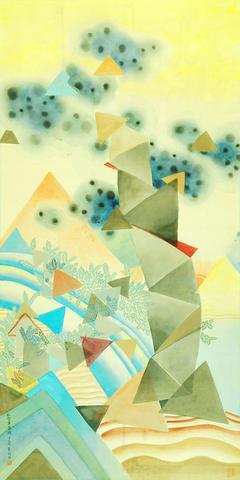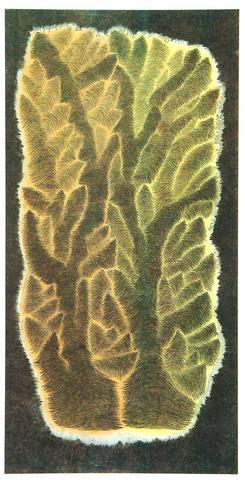Few ink painters can win over curators to include them in contemporary art exhibitions. College art students have long been discarding Chinese painting in favor of installations and videos. Leafing through any contemporary art publications, you almost never come across ink. The connection between ink painting and contemporary art would seem to be a flimsy one at best, but the Taipei Fine Arts Museum (
An exhibition at the museum, curated by its research staff, showcases the often overlooked modernity of ink. Contemporary Ink Painting and Ink in Contemporary Art, (當代水墨與水墨當代) according to Lei Yi-ting (雷逸婷), the curator of the show, aims to illustrate the two meanings of the term "contemporary."

PHOTO COURTESY OF TFAM
"One of the meanings is more literal. We include works representative of the development in ink painting in the past 20 years. The other meaning is the contemporary characteristics of the artists. They do not see themselves as ink painters and they abide by no codes of Chinese painting. They often put up installations or other works. They use ink as just one of their media," Lei said.

PHOTO COURTESY OF TFAM
About one-third of the 45 works by 13 artists come from the museum's collection, while the others are on loan from private collectors in Taiwan. The best known among these artists is Yu Peng (
Since the 1980s, Yu has followed the footsteps of ancient students of ink paintings who imitate the works of their predecessors. While ancient imitators did so to emulate the old masters, Yu made slight changes to the well-known works to express his personal quirks and also to reflect on modern life.

PHOTO COURTESY OF TFAM
The 10m-wide Dwelling in the Fu-chun Mountains (富春山居圖), named after Yuan painter Huang Gong-wang's (黃公望) famous scroll, shows childlike dots for lotus flowers, dark craggy hills typical of Taiwanese landscapes rather than those of Zhejiang province. The work seems a humorous comment on the impossibility of today's Taiwanese ink painters following the landscape traditions handed down by ancient Chinese ink painters living in a very different natural environment.
This probably explains the many landscape works (landscape is still a prominent theme in ink painting) that disregard conventional ink techniques to come up with their own ways to portray the environment of Taiwan. Lee Mao-cheng (李茂成) paints the hills around Keelung in short, dry strokes in On the Road (路途上), while his brother Lee An-cheng (李安成) applies layers of wide brush strokes to represent the humid air near mountains around the island in his Landscape (山水) series. Chang Fu-Chun's (張富峻)Circling Homeward (那載浮載沉的呻吟者向家園打轉) highlights Taiwan's island topography with a bird's eye view similar to what one sees on the plane when flying over Taiwan.
Apart from the landscapes, the sampling of works are mostly abstract studies in shapes and shades that make good use of ink's organic character. Walking around the circular gallery is a tranquil experience.
"Ink is now no more than a medium for contemporary artists, but this medium still attracts the more introspective and well-composed artists," Lei said.
Contemporary Ink Painting and Ink in Contemporary Art will run through April 25 at Taipei Fine Arts Museum, 181 Zhongshan N Rd, Sec 3, Taipei. (

US President Donald Trump may have hoped for an impromptu talk with his old friend Kim Jong-un during a recent trip to Asia, but analysts say the increasingly emboldened North Korean despot had few good reasons to join the photo-op. Trump sent repeated overtures to Kim during his barnstorming tour of Asia, saying he was “100 percent” open to a meeting and even bucking decades of US policy by conceding that North Korea was “sort of a nuclear power.” But Pyongyang kept mum on the invitation, instead firing off missiles and sending its foreign minister to Russia and Belarus, with whom it

When Taiwan was battered by storms this summer, the only crumb of comfort I could take was knowing that some advice I’d drafted several weeks earlier had been correct. Regarding the Southern Cross-Island Highway (南橫公路), a spectacular high-elevation route connecting Taiwan’s southwest with the country’s southeast, I’d written: “The precarious existence of this road cannot be overstated; those hoping to drive or ride all the way across should have a backup plan.” As this article was going to press, the middle section of the highway, between Meishankou (梅山口) in Kaohsiung and Siangyang (向陽) in Taitung County, was still closed to outsiders

Many people noticed the flood of pro-China propaganda across a number of venues in recent weeks that looks like a coordinated assault on US Taiwan policy. It does look like an effort intended to influence the US before the meeting between US President Donald Trump and Chinese dictator Xi Jinping (習近平) over the weekend. Jennifer Kavanagh’s piece in the New York Times in September appears to be the opening strike of the current campaign. She followed up last week in the Lowy Interpreter, blaming the US for causing the PRC to escalate in the Philippines and Taiwan, saying that as

The Chinese Communist Party (CCP) has a dystopian, radical and dangerous conception of itself. Few are aware of this very fundamental difference between how they view power and how the rest of the world does. Even those of us who have lived in China sometimes fall back into the trap of viewing it through the lens of the power relationships common throughout the rest of the world, instead of understanding the CCP as it conceives of itself. Broadly speaking, the concepts of the people, race, culture, civilization, nation, government and religion are separate, though often overlapping and intertwined. A government